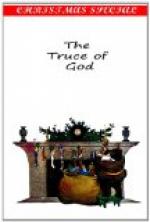“I would almost give the decade of Jura,” exclaimed Rodolph, as he approached the castle gate, “to know who made that superb pavement.”
“It resembles more the pavement of a cathedral than the simple floor of a chapel,” said Father Omehr. “I wish we had such an one to our little church at Stramen.”
“Trust that to your successor,” replied the duke; “you have given him the walls, the pillars, the windows, and the roof, and are well entitled to a pavement and alabaster altar at his hands.”
They were now at the gate, into which were cut two niches containing statutes of SS. Victor and Apollinaris. The bars, which yielded to every stranger and to every peasant, flew open before the high-born group, and the almoner, as he recognized the duke, bent his knee in reverence. They mounted a heavy flight of stairs, and, traversing an arched gallery, were ushered into the principal hall. This large room was hung with solemn tapestry, reaching from the ceiling to the floor. The characteristic piety of these ages displayed itself in the beautiful recesses in the walls, adapted to the reception of holy water, and in the devices upon the floor and ceiling, which always conveyed some pious meaning. The walls were covered with paintings chiefly relating to the exploits of the lords of Hers, or filled up with heraldic blazonry.
In the cathedral or in the castle, in the monastery or in the chapel, durability was the principal object of the architect. It is true that the genius of the age contrived to combine the greatest strength with the greatest elegance; but durability was the great end. The pious men of the Middle Ages did not erect mere shells, which, though sufficient for their own brief lives, would crumble over their posterity; but looked to the wants of future generations. And, then, there was a reliance upon posterity which is neither felt nor warranted now. Thus, in the minor Church of the Nativity in the lordship of Stramen, which had been designed by Father Omehr, and which had exhausted the revenues of the barony, the missionary had conceived it upon a scale to which his present means were insufficient, but to which the charity of another generation would be adequate. This was always the case with the cathedrals. Even the castles themselves had so many rooms set apart for recluses and wanderers, that it was easy to convert them into monasteries; and the Castle of Hers, with very little alteration, would have made an excellent convent.
Rodolph was about to throw himself into one of the large high-back chairs of state; but yielding a graceful respect to the aged priests, he motioned them to be seated, and placed himself between them.
“You are rather pale, my lord duke, from your wounds,” said the baron, as an attendant entered with some wine-cups—“and I beg you to accept from my son a draught of the vintage you used to relish.”
Rodolph received the goblet from the youth, and replied, as he raised it to his lips, “How I missed you at Hohenburg!”




